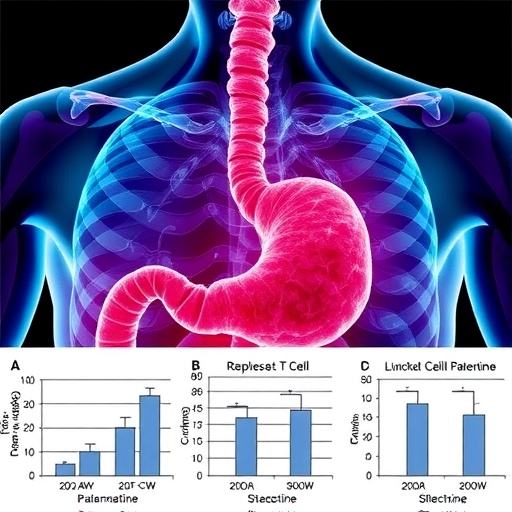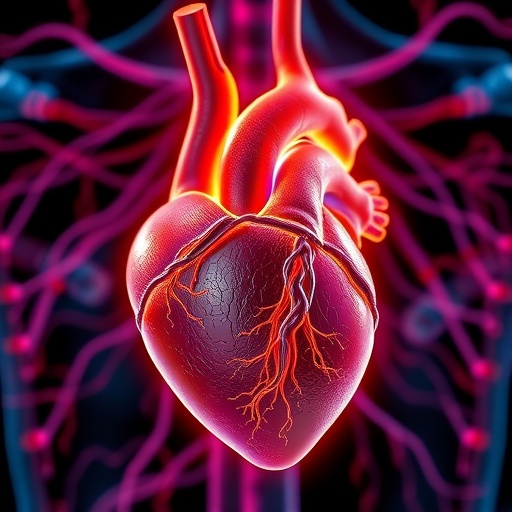A groundbreaking study has emerged from the forefront of cancer research, shedding new light on the battle against gastric cancer, one of the deadliest malignancies worldwide. Scientists have unveiled the remarkable potential of L-Tetrahydropalmatine (L-THP), a natural alkaloid compound, to enhance immune system function while simultaneously triggering ferroptosis, an iron-dependent form of programmed cell death, within gastric tumors. This dual mechanism could signal a paradigm shift in how oncologists approach treatment, offering the promise of more effective therapies that harness the body’s own defenses in tandem with novel molecular pathways.
The intricacies of the immune response in cancer have long fascinated researchers, particularly the role of cytotoxic CD8+ T cells, which are instrumental in recognizing and destroying cancerous cells. However, the efficacy of these immune cells can often be severely compromised within the hostile tumor microenvironment, which employs a range of suppressive tactics to evade immune destruction. The study highlights how L-THP boosts the activity of these CD8+ T cells, reinvigorating their capacity for tumor cell eradication. This immunostimulatory effect is crucial, as it not only magnifies cytotoxic activity but also facilitates a more sustained immune assault on the cancer.
What sets this discovery apart is the revealed synergy between immune activation and ferroptosis induction. Ferroptosis, distinct from apoptosis or necrosis, involves the lethal accumulation of iron-mediated lipid peroxides within the cancer cells, effectively causing their self-destruction. The dual action of L-THP appears to prime cancer cells for ferroptotic death while simultaneously empowering CD8+ T cells to clear residual malignant cells. This combinatorial assault exploits two biological vulnerabilities in gastric cancer that, when targeted together, may overcome resistance mechanisms that have thwarted previous treatments.
Examining the molecular underpinnings, the research delves into how L-THP modulates key signaling pathways to enhance antitumor immunity. One critical aspect is the upregulation of cytokines and chemokines known to attract and activate CD8+ T cells. Moreover, L-THP regulates the expression of GPX4 and SLC7A11, crucial regulators of ferroptosis, tipping the cellular redox balance towards lipid peroxidation and iron overload. These findings elucidate a finely tuned biochemical interaction where a natural compound orchestrates both immune potentiation and metabolic vulnerability within tumor cells.
The implications of this research are profound, especially considering the limited treatment options currently available for advanced gastric cancer. Standard approaches, such as chemotherapy and immunotherapy, often face challenges including adverse side effects, limited patient response rates, and the eventual emergence of resistant cancer clones. L-THP’s ability to synergize immune-mediated cytotoxicity with ferroptotic death offers a new therapeutic horizon that may circumvent these obstacles, potentially increasing survival rates and quality of life for patients.
Further bolstering its clinical relevance is evidence from the study’s preclinical models, where treatment with L-THP resulted in significantly reduced tumor growth and enhanced infiltration of CD8+ T cells into the tumor microenvironment. Notably, this was accompanied by markers of ferroptosis detected within tumor tissues, confirming the compound’s mechanism of action in vivo. Such promising results provide a compelling rationale for progressing towards human trials, where the benefits of L-THP can be evaluated in a clinical setting.
The multi-dimensional approach of this research not only advances our understanding of gastric cancer biology but also demonstrates the power of integrating immunology with emerging cell death pathways. By leveraging natural compounds such as L-THP, researchers may unlock novel combinatorial treatments that achieve more durable and effective antitumor responses. Importantly, the study underscores the potential of targeting ferroptosis alongside immune activation as a universal strategy that could extend beyond gastric cancer to other malignancies exhibiting similar vulnerabilities.
On a broader scale, this discovery contributes to the growing field of cancer immunometabolism, which explores the interplay between metabolic states and immune function within tumors. The manipulation of ferroptosis exemplifies how metabolic reprogramming can serve as a weapon against cancer, particularly when paired with immune modulation. Such insights are invaluable as the scientific community continues to seek therapies that are both precise and capable of addressing the complexity of tumor heterogeneity and immune evasion.
The study also raises intriguing questions about how L-THP interacts with existing treatments, such as checkpoint inhibitors or chemotherapy agents. Combining L-THP with these modalities could potentially amplify their efficacy by simultaneously dismantling cancer defenses and activating immune responses. Future investigations will be crucial to optimize dosing regimens, minimize toxicity, and identify patient populations likely to benefit the most from such combinations.
Importantly, the identification of biomarkers associated with response to L-THP-induced ferroptosis and immune activation could pave the way for personalized therapy. By profiling tumor characteristics and immune signatures, clinicians might predict which patients will respond favorably to this treatment strategy, thereby maximizing therapeutic outcomes and minimizing unnecessary exposure to ineffective interventions.
Beyond the laboratory and clinic, the success of L-THP highlights the importance of revisiting natural compounds with historical medicinal use through the lens of modern molecular biology. This reinvigoration of phytochemicals as viable cancer therapeutics underscores the potential to rediscover powerful agents hidden within nature’s pharmacopeia, now unlocked by cutting-edge research techniques and technologies.
The societal impact of such advances cannot be overstated. Gastric cancer remains a leading cause of cancer-related mortality globally, particularly affecting populations with limited access to early detection and advanced treatments. Innovations like the one presented here offer hope not only for improved clinical outcomes but also for reducing the global cancer burden through more accessible and cost-effective therapies derived from natural sources.
In conclusion, the study by Zhou et al., published in Cell Death Discovery, represents a landmark achievement in oncology research. Through meticulous investigation, the researchers have demonstrated that L-Tetrahydropalmatine amplifies cytotoxic CD8+ T cell-mediated antitumor activity while concurrently inducing ferroptosis within gastric cancer cells. This dual mechanism of action presents a compelling new strategy for therapeutic intervention, promising enhanced efficacy and the potential to overcome longstanding challenges in gastric cancer treatment.
The path forward will require collaborative efforts to translate these findings into clinical application, optimizing safety, efficacy, and integration with current therapeutic paradigms. However, the profound insights gained here mark a pivotal step towards a future where harnessing the immune system and ferroptosis in tandem could transform the landscape of cancer therapy. This research not only enriches our scientific understanding but also kindles hope for millions affected by gastric cancer worldwide.
Subject of Research: L-Tetrahydropalmatine’s role in enhancing cytotoxic CD8+ T cell-mediated antitumor immunity and inducing ferroptosis in gastric cancer.
Article Title: L-Tetrahydropalmatine synergizes cytotoxic CD8+ T mediated antitumor and ferroptosis in gastric cancer.
Article References:
Zhou, L., Wei, Y., Lin, K. et al. L-Tetrahydropalmatine synergizes cytotoxic CD8+ T mediated antitumor and ferroptosis in gastric cancer. Cell Death Discov. 11, 541 (2025). https://doi.org/10.1038/s41420-025-02825-x
Image Credits: AI Generated
DOI: 24 November 2025
Tags: cancer immunotherapy advancementsCD8+ T cells enhancementcytotoxic T cell activity stimulationenhancing immune response in tumorsferroptosis in oncologyimmune system and cancerimmunostimulatory effects of L-THPL-Tetrahydropalmatine in gastric cancernatural alkaloids in cancer treatmentnovel cancer therapiesprogrammed cell death mechanismstumor microenvironment challenges





